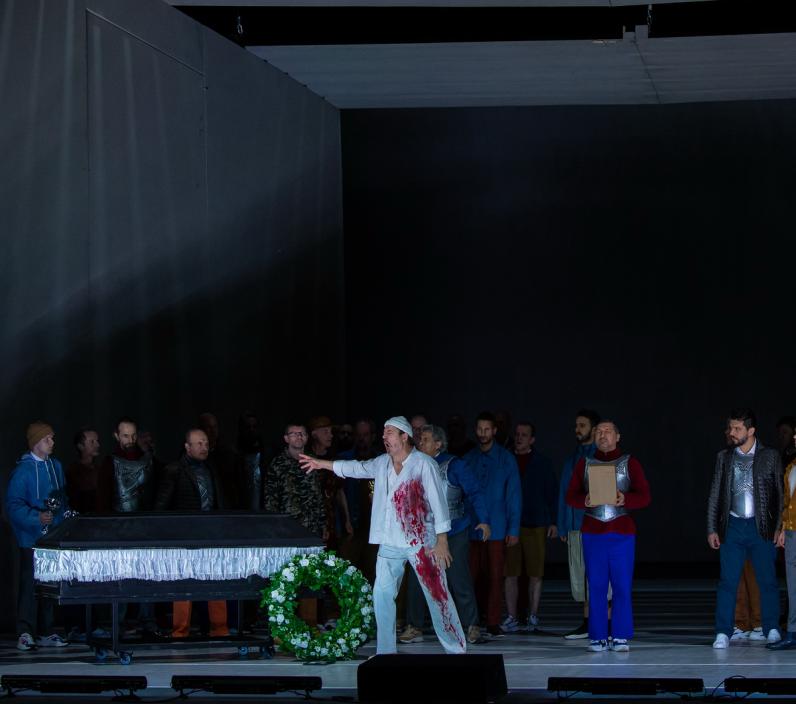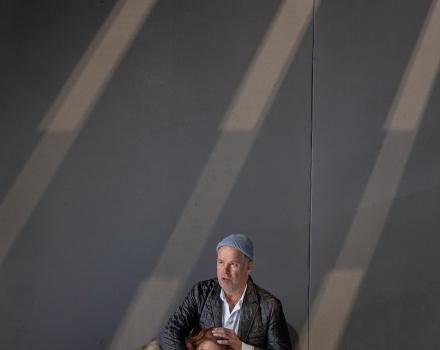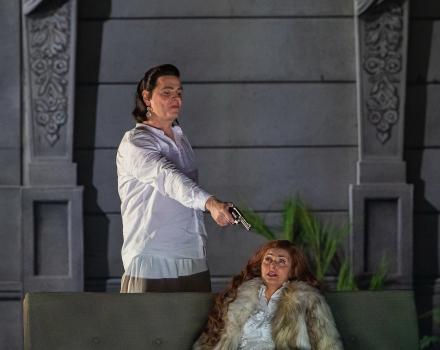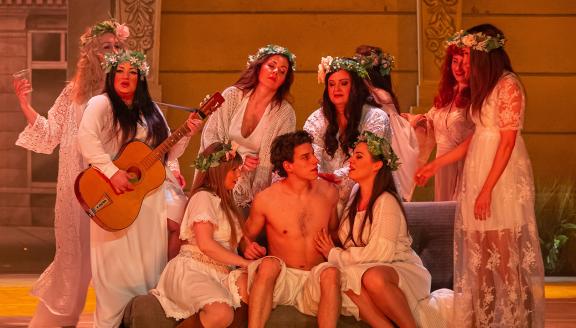

A young man ignorant of everything, including his own name, arrives at the Kingdom of the Holy Grail. Is he the ‘pure fool, enlightened by compassion’, who, it has been prophesied, will purify the realm?
In his final music drama Parsifal, Wagner fashions the fear of the temptations and sinful desires into a tale of redemption. The score contrasts the sacred with the sensual, from the stark magnificence of the music for the procession to the Grail Hall in Act I to the richly orchestrated scene in which Kundry attempts to seduce Parsifal in Act II. There are sections of almost unearthly beauty such as the Act I Prologue and the closing scene of the opera, in which Parsifal reveals the Grail to the knights. OperaVision viewers discover András Almási-Tóth’s new production conducted by Balázs Kocsár live at its premiere on Good Friday at Hungarian State Opera. Known as the Ybl Palace after its architect, Miklós Ybl, this magnificent building reopened in March 2022 after over five years of restoration.
Cast
|
Amfortas
|
Michele Kalmandy
|
|---|---|
|
Titurel
|
István Rácz
|
|
Gurnemanz
|
András Palerdi
|
|
Parsifal
|
István Kovácsházi
|
|
Klingsor
|
Károly Szemerédy
|
|
Kundry
|
Andrea Szántó
|
|
Pages
|
Eszter Zavaros, Anna Csenge Fürjes, Tivadar Kiss, Barna Bartos
|
|
Flower maidens
|
Lilla Horti, Ildikó Megyimórecz, Lusine Sahakyan, Beatrix Fodor, Boglárka Brindás (student), Melinda Heiter, Bea Egyed, Laura Fehér, Virág Rovó
|
|
Parsifal’s mother / Voice from above
|
Judit Németh
|
|
Grail knights
|
József Mukk, András Káldi Kiss
|
|
Young Parsifal
|
Benjámin Taba
|
|
Child Parsifal
|
Milos Katonka
|
|
Chorus
|
Hungarian State Chorus
|
|
Orchestra
|
Hungarian State Opera
|
| ... | |
|
Music
|
Richard Wagner
|
|---|---|
|
Text
|
Richard Wagner
|
|
Conductor
|
Balázs Kocsár
|
|
Director
|
András Almási-Tóth
|
|
Sets
|
Sebastian Hannak
|
|
Lighting
|
Tamás Pillinger
|
|
Costumes
|
Lili Izsák
|
|
Chorus master
|
Gábor Csiki
|
| ... | |
Videos
The story
Act I
In the Pyrenees, the old Knight Titurel lives in the Castle of Montsalvat where the Grail is held. His son, Amfortas, had been injured by the magician Klingsor, enemy of the Knights of the Grail, by his own Holy Spear, the arm that injured the Christ. Amfortas can only be healed by the contact with this Spear.
In the forest, around the castle, the Knight Gurnemanz and his two knaves meet Kundry, messenger of the knights of the Grail to whom Klingsor cast an evil spell. She brings a balsam from Arabia to cure the king. He accepts but it has been said that only 'an innocent with a pure heart' would be able to get the Lance back and cure him.
A young man, guilty of having killed one of the sacred swans of Montsalvat, is brought in by a troop of warriors. It’s Parsifal, a young wandering knight, who seems to know nothing about his origins.
Act II
At the Castle of Klingsor, the latter asks Kundry to entice Parsifal to make him sin, so that he can retrieve the Holy Grail. Klingsor then transforms his castle into a beautiful garden where young girls in bloom use their charm to seduce Parsifal, in vain. Only Kundry is able to do so.
As he realises that he has sinned, Parsifal composes himself and cries out his pain. Upset, Kundry understands she has to break Klingsor’s enchantment and look for redemption in Parsifal’s love. But Kundry is rejected by him, so she decides to call Klingsor who cast the Holy Spear. Parsifal seizes it, makes the sign of the cross: Klingsor and his castle get destroyed and Kundry faints.
Act III
Gurnemanz lives as a hermit not far from the mountain of Grail. Kundry visits him, asking him to serve again the Knights of the Grail when suddenly, a black-armored knight arrives: it’s Parsifal. Gurnemanz understands he is the 'innocent with a pure heart' and crown him king of Grail and baptizes Kundry. Back to the castle of Grail, Parsifal heals Amfortas by touching him with the Holy Spear. Eventually forgiven, Kundry dies.
Insights
Flesh-and-blood humans on Wagner’s stage
An interview with conductor Balázs Kocsár
Wagner referred to Parsifal as “A Festival Play for the Consecration of the Stage”. This shows that the piece is very special and is almost without equal. How does it fit in into the history of opera and the composer’s oeuvre?
Wagner not only composed music, but also wrote quite a bit, expressing his views on music and opera. These give a precise explanation for understanding his works. There are obviously precedents to what he expressed as being important to him in his writings. We consider the opera genre to stem from Monteverdi, and even he said, and wrote, that the opera is a sung narrative. Gluck also kept written documents about his endeavours to reform the genre and to give back what he considers to be the most important point in its development: the fact that operas tell a story and interpret the text. Wagner was quite familiar with French and Italian operas and, just like Ferenc Erkel in Hungary, he also said that he would like to write in his native language. Who would have thought that Der fliegende Holländer was written at the same time as Hunyadi László? Though the two pieces seem to be opposites in every sense of the word, if we observe the method for telling their stories and their dramaturgical structures, we see that both trace their roots back to popular early French and Italian operas.
I have been lucky enough to conduct Der fliegende Holländer, Lohengrin, and Tannhäuser, that is all three of Wagner’s early operas, and these can best be approached through the passion of Italian bel canto operas and the structure of the finales of French grand operas and not by starting out from Wagner’s later works. It is also interesting to note that the manner of musical thinking in the music written by Verdi in his advanced age, the schemes of those operas, and the manner in which he wrote his big scenes and monologues are very similar to Wagner’s later operas, thus also Parsifal, where the brunt of the piece consists of enormous monologues. However, it is exciting to note that the plot tends to take place in an abstract form.
The composer wrote the musical language used to compile and offset the main motifs himself, using a certain form of patterns. This approach was used by a number of artists, including Puccini, who was sent by his music publisher Ricordi to Bayreuth to study Wagner’s operas. Puccini’s main motifs are obviously present at a different level than in the case of Wagner, where they encompass almost everything: Wagner builds up his musical world by contrasting these elements and using their relationships to each other.
How can you prepare for conducting such a monumental work, and how can you then perform it?
I always approach a piece by trying to figure out why the composer wrote it in the way he did: I try to understand and decipher his intent as a composer. Contrary to the opinions of many, I do not consider Wagner’s music to be grandiose. Based on his works, I consider him to be someone who was filled with strong emotions and dynamism. Accordingly, I don’t believe we have to stage his works with an academic, distant attitude. All the monologues and narratives have to be imbibed with an energy that results in musical moments that reflect the thoughts of flesh-and-blood humans.
Does Parsifal really include flesh-and-blood people?
They are not realistic people in the manner that we see, for example, in Le nozze di Figaro. I would rather compare Wagner’s figures to the gods and heroes of Baroque operas, who act, think, and feel like us, moral and mundane humans. Although there is naturally something ethereal about Kundry, Klingsor, and even Amfortas, they still tell of real human emotions. Gurnemanz’s endless narratives where he tells of the situations he has lived through also contain a type of tension. From the aspect of the production, a narrative is exciting if it is staged by the performers dramatically and colourfully, using their own personalities.
What does Parsifal mean for your professional career?
For me, Parsifal is a milestone. When I had a chance to view the piece in Bayreuth in 1985, I was so touched that I can honestly say that is where I grew close to the opera genre and fell in love with opera. The fact that this is almost the one hundredth opera that I will be conducting is very important to me.
Gallery














